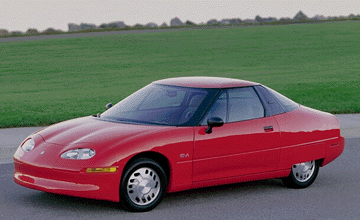
GM Announces Saturn to Market Electric Vehicle

Los Angeles -- January 4, 1996 -- Saturn Corporation will team up with General Motors to distribute and market GM's first consumer-available electric passenger vehicle. Scheduled for introduction in the fall of 1996, the vehicle will be available in select western U.S. markets. The announcement was made today at a press conference in conjunction with the Greater Los Angeles Auto Show.
Pre-production examples of the vehicle will be on display at the Los Angeles show and at the North American International Auto Show in Detroit. Both shows open to the public on Saturday, January 6.
Named "EV1" (EV, numeral one), the two-passenger coupe is an evolution of GM's Impact development vehicle. Although marketed by Saturn, it will carry the GM badge, reflecting its design, engineering and manufacturing heritage, and the partnerships involved in bringing this electric vehicle to the consumer.
GM Chairman John F. Smith, Jr. says "The EV1 will be the first modern-era passenger car developed specifically as an electric vehicle and brought to market by a major automaker. Saturn's unique brand marketing and customer emphasis will certainly help to successfully launch GM into this new segment." "Saturn is pleased to be the marketing partner in this exciting new vehicle category," notes Don Hudler, president of Saturn. "We're ready to help GM expand its technological leadership and to maximize the opportunities to develop this market. We have every intention of matching our uniquely successful Saturn philosophy with the capabilities of GM's EV1 to meet or exceed the needs and expectations of the customer."
"GM recognizes the potential environmental and energy benefits of EVs," says Bob Purcell, executive director of GM Electric Vehicles. "General Motors has every desire to make a business out of electric vehicles through the innovative technology demonstrated in the EV1, and is making the right investments to make them a market-driven success."
The EV1 by GM will initially be introduced through Saturn retail facilities serving the Los Angeles, San Diego, Phoenix and Tucson market areas. These areas afford the topographical and climatic conditions most favorable to electric vehicle operation.
GM's production of the EV1 will take place in a portion of the Lansing Craft Centre in Lansing, Michigan.
Pricing has yet to be finalized, but is expected to be in the mid-$30,000 range and will represent a fair market value to the consumer. Designed by GM specifically as an electrically-propelled passenger vehicle (thus its "purpose-built" designation), the EV1 has a bonded and welded aluminum spaceframe structure to which composite exterior panels are attached. Overall length is 169.7 inches, wheelbase is 98.9 inches and width is 69.5 inches. Its teardrop shape and other aerodynamic features yield a significantly low 0.19 coefficient of drag. Weight of the EV1 is 2,970 pounds, with the batteries accounting for approximately 1,175 pounds of that total.
The battery pack consists of 26 12-volt valve regulated lead acid modules capable of carrying 16.2 kilowatt hours of energy. A three-phase AC motor delivers 137 horsepower to the front wheels.
Battery charging is accomplished through an inductively coupled system. Unlike conductive systems, there is no metal-to-metal "plug-into-socket" connection in the transfer of electricity from a permanently wired power source. Rather, the electricity is transferred via magnetic flux. AC power from the charging unit's weatherproof paddle is converted to battery-charging DC power through the vehicle's on-board charge port.
Approximately 3 hours are required to reenergize the battery pack's state of charge from a 15 percent level using a 6.6kw charging unit running off a 220-volt (30 amp) power source. Use of a 110/120-volt (10 amp) 1.2kw convenience charger stored in the trunk requires approximately 15 hours to restore the battery pack back to full charge.
Driving range per charge can be 70-90 miles depending on a number of factors: terrain, temperature, accessory use and driving style.